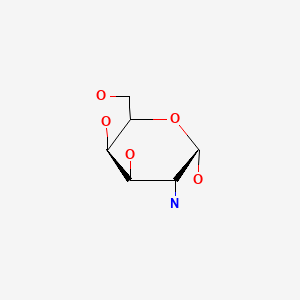Attribution Statement: LactMed is a registered trademark of the U.S. Department of Health and Human Services.
NCBI Bookshelf. A service of the National Library of Medicine, National Institutes of Health.
Drugs and Lactation Database (LactMed®) [Internet]. Bethesda (MD): National Institute of Child Health and Human Development; 2006-.
CASRN: 3416-24-8

Drug Levels and Effects
Summary of Use during Lactation
Glucosamine is an amino-monosaccharide that is either derived from shellfish or synthetically produced. Glucosamine sulfate has no specific lactation-related uses. It is most commonly used to treat osteoarthritis. A glucosamine derivative, N-acetylglucosamine, is a normal component of human breastmilk. Glucosamine sulfate is well tolerated with occasional gastrointestinal discomfort (e.g., diarrhea, heartburn, nausea, vomiting) reported. Although no studies exist on the use of glucosamine sulfate during breastfeeding, its use by a nursing mother is unlikely to adversely affect the breastfed infant.
Dietary supplements do not require extensive pre-marketing approval from the U.S. Food and Drug Administration. Manufacturers are responsible to ensure the safety, but do not need to prove the safety and effectiveness of dietary supplements before they are marketed. Dietary supplements may contain multiple ingredients, and differences are often found between labeled and actual ingredients or their amounts. A manufacturer may contract with an independent organization to verify the quality of a product or its ingredients, but that does not certify the safety or effectiveness of a product. Because of the above issues, clinical testing results on one product may not be applicable to other products. More detailed information about dietary supplements is available elsewhere on the LactMed Web site.
Drug Levels
Maternal Levels. N-acetylglucosamine is a normal component of human breastmilk. One study measured its content in the breastmilk of 8 mothers nursing fullterm infants. Average concentrations ranged from 1,459 mg/L during week 1 postpartum to 646 mg/L during week 13 postpartum. Considerable variation occurred within and between mothers at various times of the day. Two mothers of preterm infants had higher levels of N-acetylglucosamine than the mothers of fullterm infants.[1]
Another study found higher levels of N-acetylglucosamine in the breastmilk of smokers than in nonsmokers.[2]
Infant Levels. Relevant published information was not found as of the revision date.
Effects in Breastfed Infants
Relevant published information was not found as of the revision date.
Effects on Lactation and Breastmilk
Relevant published information was not found as of the revision date.
References
- 1.
- Miller JB, Bull S, Miller J, et al. The oligosaccharide composition of human milk: Temporal and individual variations in monosaccharide components. J Pediatr Gastroenterol Nutr. 1994;19:371–6. [PubMed: 7876988]
- 2.
- Milnerowicz H, Slowinska M. Concentration of metals, ceruloplasmin, metallothionein and the activity of N-acetyl-beta-D-glucosamine and gamma-glutamyltransferase in pregnant women who smoke and in those environmentally exposed to tobacco smoke and in their infants. Part I. Int J Occup Med Environ Health. 1997;10:187–202. [PubMed: 9278131]
Substance Identification
Substance Name
Glucosamine
CAS Registry Number
3416-24-8
Disclaimer: Information presented in this database is not meant as a substitute for professional judgment. You should consult your healthcare provider for breastfeeding advice related to your particular situation. The U.S. government does not warrant or assume any liability or responsibility for the accuracy or completeness of the information on this Site.
- User and Medical Advice Disclaimer
- Drugs and Lactation Database (LactMed) - Record Format
- LactMed - Database Creation and Peer Review Process
- Fact Sheet. Drugs and Lactation Database (LactMed)
- Drugs and Lactation Database (LactMed) - Glossary
- LactMed Selected References
- Drugs and Lactation Database (LactMed) - About Dietary Supplements
- Breastfeeding Links
- PubChem SubstanceRelated PubChem Substances
- PubMedLinks to PubMed
- Review Chondroitin.[Drugs and Lactation Database (...]Review Chondroitin.. Drugs and Lactation Database (LactMed®). 2006
- Review Melatonin.[Drugs and Lactation Database (...]Review Melatonin.. Drugs and Lactation Database (LactMed®). 2006
- Review Garcinia.[Drugs and Lactation Database (...]Review Garcinia.. Drugs and Lactation Database (LactMed®). 2006
- Review Beta-Carotene.[Drugs and Lactation Database (...]Review Beta-Carotene.. Drugs and Lactation Database (LactMed®). 2006
- Review SAM-e.[Drugs and Lactation Database (...]Review SAM-e.. Drugs and Lactation Database (LactMed®). 2006
- Glucosamine - Drugs and Lactation Database (LactMed®)Glucosamine - Drugs and Lactation Database (LactMed®)
Your browsing activity is empty.
Activity recording is turned off.
See more...
